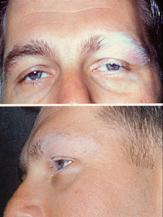Vogt-Koyanagi-Harada Disease

Vogt-Koyanagi-Harada disease is a bilateral, chronic, diffuse granulomatous panuveitis typically characterized by serous retinal detachment and frequently associated with neurological (meningitis), auditory, and dermatological alterations.
Epidemiology
Annual incidence is estimated at 1/400,000. The condition predominantly affects young women and individuals with darker pigmentation (those of Asian, Hispanic, or Native American origin). Children may be affected, but the mean age of onset is about 30 years of age (ranging from 10 to 52 years).
Clinical description
The most common clinical manifestations are headaches (67% of cases), ocular involvement with panuveitis, skin vitiligo, alopecia, and inner ear disturbances. The disease can be divided into four clinical stages. The prodromic stage is characterized by nonspecific symptoms such as fever, headaches, nausea and vertigo, and then by neurologic symptoms such as muscle weakness, hemiparesis, hemiplegia, dysarthria and orbital pain. In the ophthalmologic stage, occurring a few days after the prodromic stage, patients complain of blurred vision, ocular pain, and photophobia or central scotoma (bilateral in 80% of cases). Bilateral, serous, non-rhegmatogenous retinal detachment often occurs. Hearing disturbances (75%) and dizziness may also be present. The convalescent stage, occurring within three months of disease onset, is characterized by the apparition of cutaneous signs such as poliosis involving the eyebrows and eyelashes (and sometimes the scalp and body hair), hair loss, and vitiligo (usually perilimbal). Recurrent uveitis and ophthalmologic complications appear in the final stage, the chronic recurrent stage.
Etiology
Pathogenesis has been linked to immunological disorders targeting the melanocytes, and which involve T-cell-mediated cytotoxicity and apoptosis. However, the etiology is still not completely understood. An association between disease susceptibility and positive blood tests for the HLA-DRB1*0405 haplotype has been reported.
Diagnostic methods
Diagnosis is clinical. Cerebrospinal fluid analysis revealing pleocytosis can confirm the diagnosis.
Management and treatment
Management should involve a multidisciplinary team with dermatologists, ophthalmologists, and neurologists. High doses of corticosteroids usually provide efficient treatment, but immunosuppressors may also be used.
Prognosis
With early and aggressive treatment, the prognosis is usually favorable, but acute hearing and vision alterations may occur.